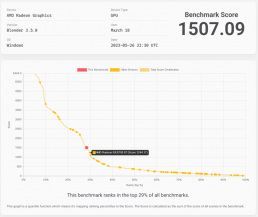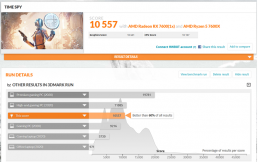AMD Radeon RX 7600 Graphics Card Review - For Gamers on a Budget
On May 24, AMD revealed its new Radeon RX 7600 graphics card. This is an entry-level card positioned to play the newest games at 60+ frames per second (fps) at 1080p. It supports very efficient streaming using the latest AV1 encoding technology. According to AMD, the card performs 1080p gaming 29% faster on average than the AMD Radeon RX 6600.
AMD’s latest RDNA 3 generation of cards have marked ray tracing improvements over the previous RDNA 2 versions. Our tests show that the Radeon RX 7600 can get close to the performance of the Radeon RX 6700 XT midrange card in ray tracing benchmarks such as Speedway and Port Royal. The RX 7600 achieved around 86% of the performance of the midrange card in both tests using default driver settings.
The Radeon RX 7600 is based on the AMD RDNA 3 architecture and includes revamped compute units with unified ray tracing and AI accelerators. It features AMD’s Infinity Cache technology from the second generation of cards.
The Test Platform
The AMD Ryzen 5 7600X processor, the Radeon RX 7600 graphics card, the GIGABYTE X670E Aorus Master motherboard, and a G.SKILL Trident Z5 Neo 2x16GB DDR5-6000 EXPO memory kit — which were all provided to IDC by AMD — comprised the test PC hardware components. The primary Windows 11 disk was a 1TB GIGABYTE Aorus NVMe Gen4 solid state drive.
A be quiet! Silent Loop 2 280mm water cooler was fitted for the processor, which was coupled with a be quiet! STRAIGHT POWER 11 Platinum 850W power supply. A 34” Dell Gaming S3422DWG monitor — a quad-HD 3440*1440 display with a 144Hz frame rate, FreeSync, 10-bit colors, and high dynamic range functionality — was also used.
The reviewers utilized the motherboard’s optimal default settings, set the memory profile to EXPO 6000, and made sure that smart access memory was enabled. No special tuning, optimization, or overclocking was carried out for the tests.
Synthetic Benchmarks and Productivity Performance
Blender Benchmark 3.5.0 was used to evaluate the graphics card’s rendering performance. The Radeon RX 7600 ranked in the top 29% of all benchmarks, thanks to the Heterogeneous Interface for Portability — AMD’s compute language for GPUs utilized by Blender Benchmark (as opposed to OpenCL, which does not utilize it). A far quicker result than expected was delivered. This is good news for gamers who do light personal and family photo editing or enhance pictures for social media posts.
The system’s 3DMark Time Spy score of 10,557 was better than 60% of all results, which is respectable for an entry-level gaming machine.
Gaming Performance
Various old and new video games were tested on the platform, including next-gen versions.
Shadow of the Tomb Raider
This game averaged 134fps at 1080p with the maximum graphics settings and AMD’s FidelityFX Contrast Adaptive Sharpening enabled. With ray traced shadow enabled at high settings, the game ran at an average 77fps with a low of 53fps. Increasing the quality of the ray traced shadow to extreme resulted in an average 70fps and a minimum of 43fps.
Far Cry 6
This game averaged 118fps at the 1080p high graphics quality setting, registering a minimum of 98fps. During testing, all DirectX Ray tracing (DXR) and FidelityFX Super Resolution (FSR) capabilities were activated. Increasing the graphics settings to ultra quality resulted in an average 99fps and a minimum of 85fps.
Cyberpunk 2077
At 1080p, this game averaged 37fps with a minimum of 22fps. Ultra ray tracing presets and FSR 2.1 capabilities were activated automatically. The game performed at an average 50fps and a minimum of 35fps using the medium ray tracing setting, resulting in a much smoother experience.
The Witcher 3: Wild Hunt Next-Gen
This game averaged 38fps at 1080p, with a minimum of 26fps. Ultra ray tracing presets and FSR 2.1 capabilities were activated automatically. The game functioned significantly better at the medium ray tracing setting, clocking an average 57fps and a minimum 46fps. Without ray tracing, rasterization performance averaged 104fps and registered a minimum of 76fps in extreme settings.
Frequency, Power Consumption, Temperature, and Noise
The RX 7600 operated at an average frequency of 2545MHz, consumed 160W of power, and attained an average temperature of 79C when playing The Witcher 3 in ultra ray tracing mode, with the GPU loaded to 99%. Due to their small size and low revolutions per minute, the two 90mm fans kept the card cool and noiseless.
Final Words and Conclusion
According to IDC’s monitor tracker, about two-thirds of new monitors still have a max resolution of 1080p. There is a massive installed base of such monitors. Not every customer with full HD aspirations is seeking the best and most costly gear. For example, Minecraft and Roblox are popular among youngsters, while Fortnite in performance mode is popular among teens. Such groups will be very delighted with a PC powered by the RX 7600, and their parents will not have to seek a loan to build it!
AMD faces increased competition now that Intel has entered the arena, alongside Nvidia and AMD. Difficult macroeconomic conditions — ranging from inflation to a war on the ground in Europe — are reducing consumer purchasing power. However, AMD has wisely evaluated the market conditions and taken quick and clever measures to adjust, such as reducing the proposed end-user price of the Radeon RX 7600 from an anticipated $299 to $269! AMD has also reduced the prices of its previous generation RDNA 2-based RX 6000 series cards, thereby providing gamers and customers with a wide selection of goods at various price points.
In conclusion, there is a lot to like about the AMD Radeon RX 7600. It is an affordable, sleek, and compact dual slot, dual fan graphics card that delivers impressive 1080p gaming performance at 50+fps on the highest graphical settings with FSR and ray tracing enabled.
GenAI: What's in it for Oil and Gas?
Oil and gas industry players have a mixed view of generative AI (GenAI). While the technology vendor community is so excited, oil and gas end-user organisations are cautious and are taking a more conservative position — for now. Maybe it’s still too early for them to commit or to comment on their next moves in the GenAI space.
This is reflected in IDC’s Future Enterprise Resilience and Spending Survey Wave 2 (March 2023), which shows that only 18% of oil and gas companies worldwide will invest in GenAI technologies this year. The remaining 82% are either neutral or are carrying out initial assessments to identify the best use cases.
Download eBook: Generative AI in EMEA: Opportunities, Risks, and Futures
Potential Use Cases for the Oil and Gas Industry
There are three main use cases where oil and gas industry early adopters will be able to generate value with GenAI:
- Asset operations: GenAI can create new data and content to enhance multiscenario authentic simulations and prediction capabilities of operational assets. It can enhance the capabilities of digital twins, predictive maintenance and asset-management-specific workflow automation.
- Upstream subsurface data analysis: GenAI can enhance images to create 3D models. It can also generate subsurface images using fewer seismic data scans, avoiding the need for repeated data acquisitions to fill the data gaps that are common in the upstream oil industry.
- Enterprise ChatGPT for business leaders: Oil and gas companies’ unstructured data is generally held by different personas in different locations. All this data can be operationalised to create instant access to the right information to support organisations’ leadership in business decisions. Large language models (LLMs), such as ChatGPT, can play a crucial role here as they can generate human-like text, respond to domain questions and be used in the form of chatbots and virtual assistants.
Watch the Webcast: Generative AI in EMEA: Opportunities, Risks, and Futures
Uncertainties
There are lot of uncertainties around the adoption of GenAI, such as development of new regulatory frameworks and organisations’ data security. Also, with oil and gas companies seeking to improve their ESG performance and making a serious commitment to net-zero emissions, they are trying to adopt new technologies to operate their business efficiently but with minimum possible environmental impact. One operational concern is the sustainability credentials of GenAI technologies, as the technology could have a huge carbon footprint. The training of a single common natural-language processing AI model, for example, emits nearly five times the emissions of a single car during its lifetime.
With GenAI at the early stages of adoption, there are still questions about how it will support business outcomes. How industries such as oil and gas utilise it will depend on how effectively it supports and enhances performance, while mitigating the risks that come with adopting a new technology. For the oil and gas market it seems that in the short term it’s a case of watch this space.
How Generative AI is Impacting Industries
Generative AI is a fascinating topic and has emerged as a powerful technology that pushes the boundaries of what computation can accomplish.
It has the potential to transform the realms of art and creativity, but also revolutionise industry processes.
There are a myriad use cases of generative AI across industries. We can see that different industries are adopting the technology to achieve specific business outcomes or address common challenges every organisation faces.
With its ability to generate content autonomously and simulate human-like outputs, generative AI has found applications in all industries. In fields as diverse as marketing, customer experience, citizen engagement, as well as industry-specific processes, such as supply chain management automation in manufacturing, for instance.
We would like to start diving into the use cases that are commonly used by several industries.
One of the first use cases to be adopted by organisations are conversational applications. They can range from virtual assistants and chatbots to language translation to personalised recommendations.
Another use case spanning across industries is in marketing applications, which can be widely adopted, depending on the sensitivity of the customer/citizen/patient data and the industry appetite for online marketing. For example, social media automation, customer support via chatbots and personalised marketing campaigns can be used to enhance the visibility of the organisation while being more efficient in their marketing investments.
A third use case cutting across industries is knowledge management applications. This use case can be seen in organisations being applied in identifying existing knowledge, knowledge summarisation, and in language translation and geographic contextualisation.
Download eBook: Generative AI in EMEA: Opportunities, Risks, and Futures
However, industries adopt technologies based on their specific needs, goals, and customer demands. Unique processes, regulations, and market dynamics require tailored technologies, and it will be no different with generative AI.
Diverse industry requirements, resource constraints, competition, and technological maturity stages drive varying technology adoption across organisations. Now we’d like to explore how several industries are approaching generative AI and the technology adoption patterns of each industry:
Finance
In the ever-evolving landscape of the financial services industry, the emergence of generative AI technologies, led by Open AI’s ChatGPT, has garnered significant attention from CIOs.
While some express concerns regarding privacy and ethics, and others grapple with understanding the full potential, there is a growing sense of urgency driven by the fear of missing out (FOMO). Contrary to sceptics’ concerns, the industry has demonstrated a shift in focus towards augmenting the capabilities of financial services professionals, rather than seeking to replace them.
By harnessing the power of large language models, financial institutions aim to centralise knowledge, empowering agents and professionals with essential information to enhance customer experiences and optimise operational efficiency.
An excellent example of this progressive trajectory is Sedgwick, a prominent global provider of third-party claims administration services. It has successfully integrated the Open API version of ChatGPT, named “Sidekick,” into its sophisticated claims system, exemplifying Sedgwick’s commitment to elevating its claim-handling process and delivering unparalleled customer service experiences.
Another notable application gaining traction involves leveraging generative AI to enhance conversational interfaces. By revolutionising conversational capabilities, generative AI enables more human-like responses and facilitates complex interactions. Helvetia, a pioneering force in the insurance services realm, has embarked on a bold endeavour by launching a direct customer contact service utilising OpenAI’s ChatGPT.
This experimental initiative aims to provide seamless access to various financial products, showcasing the vast potential of generative AI in transforming customer interactions.
Energy (Utilities and Oil & Gas)
According to a recent IDC Survey ― Future Enterprise Resiliency & Spending Survey Wave 2, March 2023 (FERS) ― the utilities industry globally ranks second highest in terms of investments in generative AI technologies for 2023 (40% of respondents), surpassing the global cross-industry average of 24%.
This highlights the enormous potential for innovation, the amplification of human work, and reinvention of work processes in utility companies. The automation of certain tasks and AI-assisted transformation are expected outcomes.
While the utilities industry is still in the exploratory phase of identifying fruitful use cases, generative AI holds significant promise in areas such as content generation for sales and marketing code-generation applications. To improve productivity and employee experience, conversational applications for customer service and CX improvements, and knowledge management, which is especially crucial given the challenge of an aging workforce in the utilities sector.
On the other hand, oil and gas organisations appear to be adopting a more conservative position.
The FERS survey reveals that only 18% of oil and gas companies worldwide are willing to invest in generative AI technologies in 2023.
However, 82% are actively conducting initial assessments to identify potential use cases. These assessments include evaluating the use of generative AI for multi-scenario authentic simulations and predictive capabilities in asset operations, generating subsurface images using fewer seismic data scans in the upstream part of the business, and generating human-like text to provide responses to domain-specific questions for business leaders.
Manufacturing
The early months of 2023 witnessed a surge of interest in generative AI and a renewed focus on AI in general.
While manufacturing organisations have not been early adopters of generative AI, they are gradually recognising the technology’s potential for leveraging vast research resources to create diverse content, including text, video, images, and virtual environments.
Among the respondents to the IDC 2023 Manufacturing Survey, 27% are already investing in generative AI technologies, and an additional 38% are engaged in basic exploration. Knowledge marketing and marketing applications are areas where organisations see short-term benefits, likely due to the availability of user-friendly technology that is easily accessible, such as ChatGPT.
Moreover, manufacturers believe that generative AI can have a significant medium-term impact on various aspects of their operations, such as production planning, quality control, AI-driven maintenance, code generation for programmable logic controllers, product development, design (including modelling, testing, and product life-cycle management), and sales (including client data analysis and content management).
However, there are ongoing challenges in maximising the value of AI/ML in manufacturing organisations. Many organisations still lack the necessary tools to address issues related to data availability and quality. IDC observes that internal capabilities and training in leveraging AI-powered technology and analytical tools are often lacking.
Read blog: Gen AI in an Industrial Environment — Recommendations for Early Adopters
Government
Generative AI tools such as ChatGPT, Bard, Dall-E 2, Vall-E, Stable Diffusion, and others have rapidly transitioned from arcane terms known only to AI experts to subjects of popular discussion in newspapers and TV talk shows within a matter of months.
OpenAI’s launch of ChatGPT in late 2022 sparked a wave of curiosity and speculation among the public, private companies, and public administrations. Initially, policymakers exercised caution, but senior civil servants quickly developed an interest in generative AI. Consequently, some jurisdictions have begun issuing guidelines.
The United Arab Emirates government, for example, has released guidelines encouraging the use of generative AI and providing ideas for potential use cases.
The Portuguese government has announced the “Practical Guide to Access to Justice,” which utilises the ChatGPT platform to help citizens obtain legal information in layman’s terms.
In another intriguing instance, a member of the Italian parliament used generative AI to write a speech, surprising fellow senators by disclosing its computer-generated nature at the end of the debate.
In the long term, generative AI has the potential to improve citizen experiences, amplify the competencies and capacity of civil servants, who often face overwhelming amounts of documents and cases, and aid administrations struggling to hire new talent.
At present, however, no major government entities in Europe, the Middle East, and Africa (EMEA) have implemented generative AI at scale. Nevertheless, numerous ideas, pilots, and prototypes are under development to understand the potential benefits in terms of citizen and employee experiences, increased operational efficiency, enhanced trust and compliance, environmental sustainability, and the governance and technical challenges that need to be addressed.
Healthcare
European healthcare organisations are increasingly recognising the benefits of generative AI in empowering and engaging patients and clinicians.
The most promising area of investment lies in knowledge management applications that enable a more efficient and effective flow of information among healthcare professionals, ultimately leading to better patient care.
For instance, generative AI can be employed to create or integrate more accurate patient histories and identify disease patterns, significantly enhancing the ability to make accurate diagnoses and develop effective treatment plans.
However, effective implementation of generative AI in healthcare faces limitations related to both data and models. Generative AI models require extensive training on large volumes of high-quality data.
Healthcare data quality varies widely, and its availability can be restricted due to privacy and ethical concerns. Additionally, generative AI models have limitations in terms of reproducibility due to their probabilistic nature and complex architecture. This undermines the reliability and trustworthiness of the models, especially when used to support clinical decision-making.
Read blog: Generative AI in Healthcare: Benefits and Risks
Retail
The retail industry is moving faster than the human pace can keep up with. Evolving customer expectations and needs, fierce competition, and the quest for enhanced process efficiency ― among others ― are all factors driving retailers to rush into experimenting with emerging technologies.
In fact, in 2022 newspapers were crowded with titles of bold retailers and brands landing in the metaverse while, in 2023, the focus has already shifted to generative AI. However, while the metaverse initiatives of retailers have already cooled down in favour of new forms of (spatial) computing, generative AI technologies (such as ChatGPT and Dall-E) and solutions powered by LLMs or text-to-image models could have a major transformational business impact across the retail value chain.
IDC data shows that 40% of retailers are in the initial exploration phase of the technology, while 21% are actively investing in the implementation of generative AI tools for the year ahead. We can already see some relevant applications in the areas of product development, merchandising, supply chain, marketing, and customer experience.
Organisations such as Coca-Cola, Mattel, and Carrefour are piloting generative AI applications ― even though still on a limited scale and predominantly with a test-and-learn approach.
According to IDC findings, 50% of retailers are expecting to prioritise generative AI uses cases for marketing in the next 18 months. In particular, generative AI could have a tremendous impact on the automation and personalisation of resource-intensive and time-consuming ecommerce processes such as product page descriptions, images/videos, and marketing copies.
For example, the Chinese ecommerce giant JD.com announced the imminent release of its own retail-specific ChatGPT solution which aims to improve online retailers’ rankings of product listings on SERP, generate product descriptions that are tailored to a shopper’s preferences, and optimise online product images and video generation processes.
Overall, as shown by the IDC data cited above, the most promising and imminent area of investment for generative AI in the retail sector is marketing and, more specifically, digital marketing.
Even if, in the near future, the technology could raise important questions in terms of proprietary data sharing and customer data privacy, without a doubt the use of generative AI for text and image generation could greatly enhance and streamline the ecommerce shopping experience, leading to higher profitability of retailers’ online channels.
Architecture, Engineering, and Construction
The built environment sector has long been considered behind the curve when it comes to productivity and the adoption of digital technology. But emerging technologies, including generative AI, are accelerating innovation across the sector and aligning it with other industries.
According to an IDC Survey (Future Enterprise Resiliency & Spending Survey Wave 2, IDC, March 2023), 25% of resource and construction companies are investing in generative AI technologies this year, just above the industry average.
The potential of generative spans across the building life cycle. When planning and designing a building, drawings and BIM models typically take weeks or months to produce. Generative AI has the potential to generate building designs in an afternoon based on pre-defined criteria such as building codes, site conditions, and sustainability standards.
The construction process is also ripe for innovation: studies find that the need to correct errors during projects accounts for between 5% and 12% of costs. Here, generative AI can create optimised construction schedules and augment supply chain and material planning.
The opportunities extend to a building’s operation through to its demolition and recycling.
As with all industries, these opportunities must be balanced with potential risks. For AEC companies, there are specific physical safety risks associated with using generative AI for the automation of building designs and compliance checks. The correct safeguards and checks will need to be put in place as these technologies are piloted and rolled out.
Generative AI models also require extensive training on large high-quality data sets: the industry’s legacy of digital immaturity and data fragmentation will affect, but not stall, the rate of innovation.
Moving Forward
In conclusion, as the field of generative AI continues to evolve rapidly, it is paramount to cultivate strategies that enable us to navigate through the noise and discern between hype and reality.
Register for the Webcast: Generative AI in EMEA: Opportunities, Risks, and Futures
By gaining a clear understanding of the true potential and limitations of this technology, we can effectively harness its power. The wide-ranging applications of generative AI across various industries have the potential to reshape the way organisations manage their businesses and increase efficiency and productivity.
However, amid the excitement and buzz, it is vital to approach the subject with a discerning eye. Adopting an approach based on use cases, which reveals tangible evidence based on real-world results, becomes an imperative for tech vendors and end-user organisations alike.
Drawing upon practical applications and real-world experiences provides invaluable context, allowing us to differentiate between exaggerated claims and genuine achievements. By prioritising the examination of use cases and seeking concrete results, we deepen our understanding of the true potential and limitations of generative AI.
Another angle of the discerning strategy when it comes to generative AI is to rely on subject experts and look for insights that are connected to the industry in question, as experienced professionals in the field are the best source of reliable and up-to-date information. Moreover, this article was written by several humans, embedded by human intelligence with the help of computers, not generative AI.
Contributing analysts: Adriana Allocato, Davide Palanza, Gaia Gallotti, Jan Burian, Louisa Barker, Massimiliano Claps and Sofia Poggi
If you want to know more about generative AI visit our website, or for more in-depth industry insight click here.
River Cities: Using Technology and Smart City Thinking to Instrument Rivers
Many cities owe their existence to the proximity of a river but in recent times we have separated the development of a river from the built environment of the city. We have an opportunity to maximize the river asset and add value through what we have learned in the smart city arena and leveraging rapidly maturing technology such as digital twins, AI, Edge and IoT for both the natural and built environment.
Early peoples settled by rivers because they were a source of water, food, trade, irrigation, transportation, recreation, access and egress. They were so valuable that fortifications were built to control access, and these grew into Major Cities. The identity of a city is linked to its river, and it is difficult to imagine cities such as London without the Thames, Paris without the Seine and the river Moscow gave the city its name.
Today, new regeneration activity often starts with riverside property that soon becomes the most valuable in a city.
With the industrial revolution and increases in population, river pollution rose to the point where many inner-city rivers were dead. A number of factors are aligning to bring those rivers back to life.
Firstly, environmental awareness is rising.
Secondly, heavy industry has or is moving out of cities and thirdly, as cities become more congested, alternative means of transport are being sought and lastly, we now have the technology to better understand, monitor and improve a river.
London has changed dramatically in the last 30 years and in that incredibly short space of time the Thames has come back from the dead. It now has fish, turtles and dolphins. Well, the odd dolphin and turtle that probably lost their satnav but at least they did not gag and die on entering the Thames.
At a global level It is already happening.
The Namami Gange project is a major $9Billion initiative undertaken by the Indian government to rejuvenate and clean the Ganga River, one of the most sacred and culturally significant rivers in India. The project was launched in 2015 as a comprehensive approach to restore and protect the Ganga River and its tributaries. The Namami Gange project is a multi-disciplinary effort that involves collaboration between various government ministries, departments, and agencies at the central and state levels. Its long-term vision is to ensure the ecological and cultural integrity of the Ganga River, benefitting millions of people who rely on the river for their livelihoods and spiritual practices.
When we looked at what they were doing, it was a linear version of what we are trying to do in smart cities. Instrumenting the river to monitor, measure, predict and effect change across 2500 kilometres of the country.
The Ganges programme is still ongoing and can be seen as the ‘Everest’ of current Smart River Projects. An earlier project, the Cheonggyecheon River project in South Korea, was a significant urban renewal and restoration project that aimed to revive and transform the Cheonggyecheon River, a historic polluted waterway that had been covered by a highway.
The project, which was completed in 2005, achieved several notable outcomes around environmental restoration, improved water management and enhanced urban aesthetics, increased connectivity and economic growth.
Climate change is accelerating interest in more effective water management and the adoption of the UN’s Strategic Development Goals. “The establishment of Sustainable Development Goal 6 (SDG 6) “Ensure availability and sustainable management of water and sanitation for all” confirms the importance of water and sanitation in the global political agenda. SDG 6 addresses the sustainability of water and sanitation access by focusing on the environmental aspects of freshwater ecosystems and resources – including their quality, availability and management.”
River usage can also cause international conflict. The land between the Tigris and Euphrates is where cities arguably began and the damming and gravel mining of the river in Turkey is changing the flow of the water that is critical to the city of Bagdad and the wider Iraq economy.
The same can be said of the Nile that flows through or along the border of eleven African countries. Many of the potential areas of conflict such as water removal, pollution, mining and flooding could be ameliorated through using technology to build a better understanding of a river. Through instrumenting it with sensors and connecting the information produced to digital twins to make the information accessible and allowing for scenario planning and predictive interventions.
We have developed an IDC Market Perspective Report that looks at policy and governance issues and gone into more detail on how technology such as digital twins, sensors, data, AI, 5G, edge, cloud and social media can be used in this arena, click here to find out more.
We will be researching deeper into the subject of River Cities and also the wider subject of Smart Rivers and would be keen to hear about case studies globally.


















